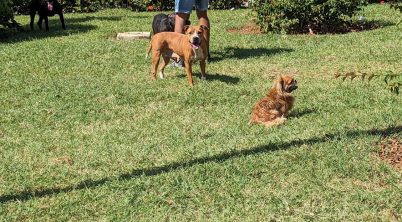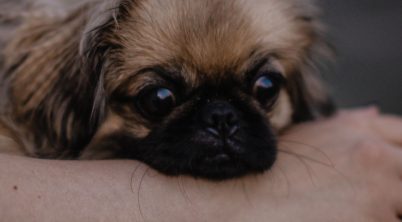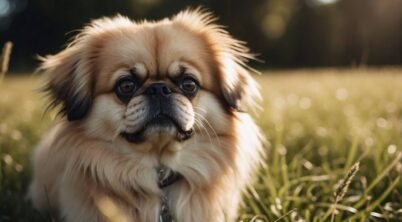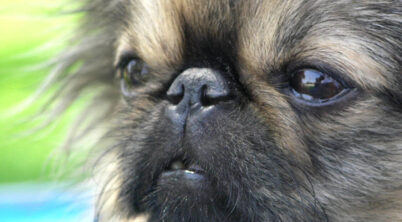The Pekingese is a distinct toy dog breed known for its regal and lion-like demeanor. Originating from the royal courts of ancient China, this breed has a long and storied history, which includes being the cherished companions of Chinese emperors. Their small size and unique flat faces with a lion’s mane of fur make them easily recognizable and endearingly popular. These dogs carry themselves with a dignified presence which reflects their aristocratic heritage.
When considering the Pekingese as a pet, it’s important to weigh both the positive and negative aspects of the breed. Among the pros is their loyal nature; Pekes often form strong bonds with their owners and can be quite affectionate. They are also relatively low-energy dogs, which can make them suitable for apartment living and less active households. Their small size makes them convenient travel companions and easier to manage in smaller living spaces.
However, the Pekingese breed is not without its cons. Their long, luxurious coat requires regular grooming, which can be time-consuming and may incur additional expense for professional services. Healthwise, they are prone to certain issues due to their brachycephalic (short-muzzled) faces, such as respiratory problems, and they can sometimes display stubborn behavior that might challenge training efforts. Prospective owners must consider these factors carefully to determine if a Pekingese is the right fit for their lifestyle and environment.
Table of Contents
Pekingese Pros and Cons
The Pekingese breed is known for its distinct personality and physical characteristics, presenting a set of advantages and disadvantages to prospective owners.
Pekingese Pros
- Affectionate: They tend to form deep bonds with their families, offering love and companionship.
- Alert: With a history as imperial watchdogs, they remain vigilant and can serve as good alert dogs.
- Low Exercise Needs: Their small size means they don’t require extensive exercise, making them suitable for apartment living.
- Loyal: Often described as brave and loyal, they usually have a strong sense of allegiance to their owners.
Pekingese Cons
- Grooming: They have a long, beautiful coat that requires regular grooming to prevent matting.
- Health Issues: Susceptible to breathing problems due to their flat faces, and may experience other health concerns common to small breeds.
- Stubbornness: Training a Pekingese can be challenging due to their independent and sometimes stubborn nature.
- Heat Sensitivity: Their thick coat and short snout make them prone to overheating, so they must be kept cool in warm climates.
Physical Characteristics
The Pekingese boasts a distinct and regal appearance, characterized by a luxuriant coat and a bold physical structure reflecting its noble lineage.
Coat and Color Varieties
Coat: The Pekingese is enveloped in a long, coarse, double coat that demands regular grooming. It’s further adorned by a flowing mane, reminiscent of a lion, which extends over the neck and shoulders, giving it a majestic look.
Color Varieties: The breed comes in an array of colors that includes, but is not limited to, red, white, sable, cream, black, gray, and fawn. Notably, Pekingese coats may also be parti-color, which entails a combination of any of the above with white.
Size and Appearance
Size: They are categorized broadly within the toy group, with a height typically ranging from 6 to 9 inches.
Weight: Pekingese are petite yet sturdy canines, weighing up to 14 pounds once fully grown.
Appearance: They possess a compact, stocky body, slightly bowed limbs, and a short tail. The head is notable for its short snout, large expressive eyes, and a characteristic “V-shaped” facial wrinkle. The overall stature of the breed exudes confidence.
Personality Traits
Pekingese dogs possess a rich blend of personality traits ranging from affectionate to stubborn, all influenced by their regal ancestry and toy breed characteristics.
Behavioral Tendencies
Pekingese dogs typically display a stubborn and opinionated demeanor, which can be attributed to their self-assured nature. Their temperament is a mix of affectionate loyalty and dignified independence. While they form tight bonds with family, they often exhibit a willful streak, making consistency in training crucial. Pekingese are alert and can be quite protective, often serving as vigilant watchdogs who are ready to sound the alarm when needed.
- Temperament: Affectionate, dignified, independent
- Common Behaviors:
- Alertness: High
- Protectiveness: Moderately high
- Stubbornness: Can be significant
Social and Training Aspects
The training of a Pekingese can reflect their intelligent but sometimes willful personalities. They learn best with patient and persistent trainers who respect their independent spirits. Socialization is essential for this breed to nurture their friendly and loving side. They can be affectionate and playful, enjoying a good romp, but also need to be taught to interact appropriately with children and other animals due to their innate regality and distinction.
- Training Needs:
- Intelligence: High
- Stubbornness: Can be challenging
- Social Preferences:
- With Family: Highly affectionate and loving
- With Strangers: Friendly when properly socialized
Health and Care
The Pekingese is a breed with distinct health and grooming requirements. Careful attention to its grooming needs and awareness of potential health issues are essential to maintaining its well-being.
Grooming Needs
- Daily Grooming: The Pekingese has a long, coarse, double coat that requires daily brushing to prevent mats and tangles.
- Occasional Baths: While daily brushing is crucial, they only need an occasional bath as over-bathing can strip the coat of natural oils.
- Focus on Eyes and Face: Due to their facial structure, regular cleaning of the eye area is necessary to prevent irritation.
Common Health Issues
- Short Snout Respiratory Issues: The breed’s short snout can lead to breathing difficulties, making it crucial to monitor their respiratory health.
- Intervertebral Disc Disease: Pekingese can be prone to this condition due to their build; regular check-ups can help in early detection.
- Risk of Obesity: A balanced diet and controlled nutrition are vital as they have low exercise needs and can easily become overweight without proper care.
By adhering to a regular grooming schedule and maintaining vigilance for these health concerns, Pekingese owners can help ensure their pets live a comfortable and healthy life.
Living Requirements
The Pekingese dog breed, known for its distinctive lion’s mane and compact form, has specific needs when it comes to their living environment. These dogs are adaptable to a variety of settings but thrive in conditions that cater to their physical and psychological needs.
Housing Considerations
The Pekingese is well-suited for apartment living due to its small size. However, they do require a peaceful atmosphere as they can be sensitive to loud noises and chaos. While generally quiet, Pekingese may bark to alert their owners, making them effective, albeit not excessive, watchdogs. Space for play is advantageous, emphasizing the need for safe, designated areas where they can engage in activities without injury, given their short legs and long backs.
- Apartment-friendly: Yes, with noise sensitivity in mind.
- Barking Tendencies: Moderate alert barking.
Exercise and Engagement
Though the Pekingese has a relatively low energy level, they require regular, moderate exercise to maintain health and stave off boredom. Short daily walks or play sessions are usually sufficient. They are playful and enjoy engaging in games that stimulate their minds. Ensuring they are properly socialized is crucial, especially if they live in multi-pet households.
Given their history as companions to royalty, the Pekingese demands a certain level of attention and does not like to be ignored. They form strong bonds with their family members and make excellent family pets when integrated into the home with care and respect for their needs.
- Exercise Needs: Moderate; short walks and play sessions.
- Playfulness: Enjoy play but within their physical limits.
- Attention Requirement: High; thrive on interaction and companionship.








